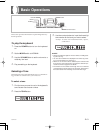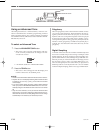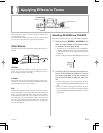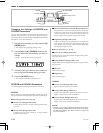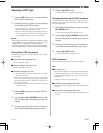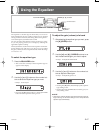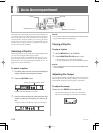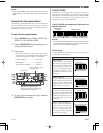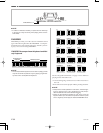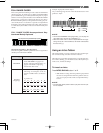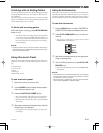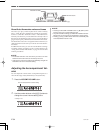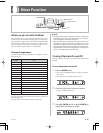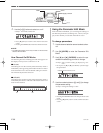
E-29
❚
NOTE
• Pressing both TEMPO buttons (̆ and ̄) at the same time
resets the tempo to the default value of the currently selected
rhythm.
Using Auto Accompaniment
The following procedure describes how to use the keyboard’s
Auto Accompaniment feature. Before starting, you should
first select the rhythm you want to use and set the tempo of
the rhythm to the value you want.
To use Auto Accompaniment
1. Set the MODE switch to CASIO CHORD, FIN-
GERED, or FULL RANGE CHORD.
2. Press the START/STOP button to start play of the
currently selected rhythm.
3. Play a chord.
• The actual procedure you should use to play a chord
depends on the current MODE switch position. Refer
to the following pages for details on chord play.
CASIO CHORD.............................. This page
FINGERED ...................................... Page E-30
FULL RANGE CHORD ................Page E-31
4. To stop Auto Accompaniment play, press the
START/STOP button again.
Melody keyboard
Accompaniment
keyboard
❚
NOTE
• The accompaniment keyboard can be used for playing chords
only. No sound will be produced if you try playing single melo-
dy notes on the accompaniment keyboard.
Chord Types
CASIO CHORD accompaniment lets you play four types of
chords with minimal fingering.
CASIO CHORD
This method of chord play makes it possible for anyone to
easily play chords, regardless of previous musical knowledge
and experience. The following describes the CASIO CHORD
“accompaniment keyboard” and “melody keyboard,” and
tells you how to play CASIO CHORDs.
CASIO CHORD Accompaniment Keyboard and
Melody Keyboard
R o c k
Chord name
Current measure number
and beat number
Basic fingering of current chord
(May be different from chord actually
being played on the keyboard.)
703A-E-031A
Major chords
Major chord names are marked
above the keys of the accompa-
niment keyboard. Note that the
chord produced when you
press an accompaniment key-
board does not change octave,
regardless of which key you use
to play it.
Minor chords (m)
To play a minor chord, keep the
major chord key depressed and
press any other accompaniment
keyboard key located to the
right of the major chord key.
Seventh chords (7)
To play a seventh chord, keep
the major chord key depressed
and press any other two accom-
paniment keyboard keys locat-
ed to the right of the major
chord key.
Minor seventh chords (m7)
To play a minor seventh chord,
keep the major chord key de-
pressed and press any other
three accompaniment key-
board keys located to the right
of the major chord key.
Example
Chord Types
CDEFGABCDEF
C Major (C)
CDEFGABCDEF
C minor (Cm)
CDEFGABCDEF
C seventh (C7)
CDEFGABCDEF
C minor seventh (Cm7)



